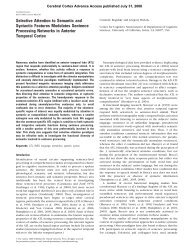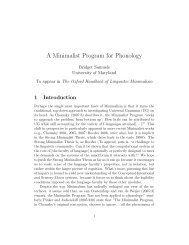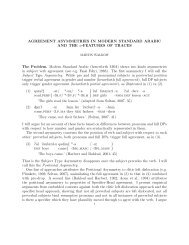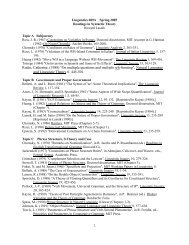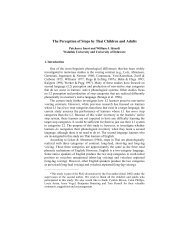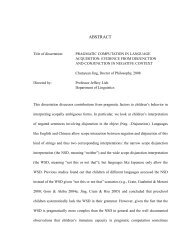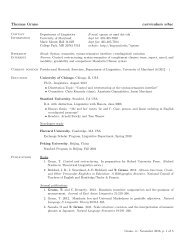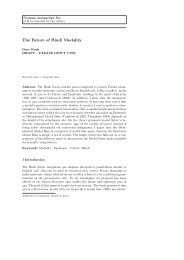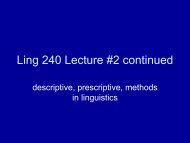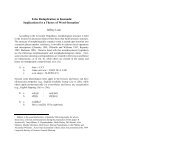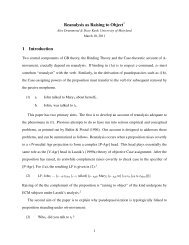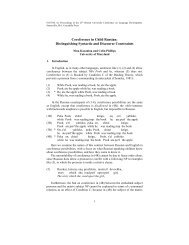action-memory loop David Poeppel and William Idsardi - Linguistics
action-memory loop David Poeppel and William Idsardi - Linguistics
action-memory loop David Poeppel and William Idsardi - Linguistics
You also want an ePaper? Increase the reach of your titles
YUMPU automatically turns print PDFs into web optimized ePapers that Google loves.
Recognizing words from speech: the perception<strong>action</strong>-<strong>memory</strong><br />
<strong>loop</strong><br />
<strong>David</strong> <strong>Poeppel</strong> <strong>and</strong> <strong>William</strong> <strong>Idsardi</strong><br />
1. Conceptual preliminaries<br />
1.1. Terminological<br />
The failure to be sufficiently careful about terminological distinctions<br />
has resulted in some unnecessary confusion, especially when considering<br />
the neurobiological literature. For example, the term speech perception has<br />
unfortunately often been used interchangeably with language comprehension.<br />
We reserve the term language comprehension for the computational<br />
subroutines that occur subsequent to the initial perceptual analyses. In particular,<br />
language comprehension can be mediated by ear, eye, or touch. The<br />
linguistic system can be engaged by auditory input (speech), visual input<br />
(text or sign), <strong>and</strong> tactile input (Braille). In other words, the processes that<br />
underlie language comprehension build on sensorimotor input processes<br />
that appear to be, at least in part, independent. While this point may seem<br />
pedantic, the literature contains numerous reports that do not respect these<br />
distinctions <strong>and</strong> that conflate operations responsible for distinct aspects of<br />
perception <strong>and</strong> comprehension.<br />
We focus here on speech perception proper, the perceptual analysis of<br />
auditory input. Importantly, further distinctions must be considered. There<br />
are at least three experimental approaches grouped under the rubric ‘speech<br />
perception,’ <strong>and</strong> because they are different in the structure of the input, the<br />
perceptual subroutines under investigation, <strong>and</strong> the putative endpoint of the<br />
computations, it is important to be cognizant of these distinctions, too.<br />
(a) Most research on speech perception refers to experimentation on<br />
specific contrasts across individual speech sounds, i.e. sub-lexical/prelexical<br />
units of speech. Subjects may be presented with single vowels or<br />
single syllables <strong>and</strong> asked to execute particular tasks, such as discrimination<br />
or identification. In a typical study, subjects listen to consonant-vowel<br />
(CV) syllables drawn from an acoustic continuum -- for example series<br />
exemplifying the /ra/-/la/ tongue-shape contrast or the /bi/-/pi/ voicing contrast<br />
-- <strong>and</strong> are asked upon presentation of a single token to identify the<br />
stimulus category. This research strategy focuses on sublexical properties
2<br />
of speech <strong>and</strong> typically examines questions concerning the nature of categorical<br />
perception in speech (e.g. Liberman 1996), the phonemic inventory<br />
of speakers/listeners of different languages (e.g. Harnsburger 2000), perceptual<br />
magnet effects (e.g. Kuhl 2007), the changes associated with first<br />
(e.g. Eimas et al 1971) <strong>and</strong> second language learning (e.g. Flege <strong>and</strong> Hillenbr<strong>and</strong><br />
1986), phonotactic constraints (e.g. Dupoux et al 1999, Kabak <strong>and</strong><br />
<strong>Idsardi</strong> 2007), the role of distinctive features (e.g. Kingston 2003), <strong>and</strong><br />
other issues productively addressed at the pre-lexical level of analysis.<br />
This work has been immensely productive in the behavioral literature<br />
<strong>and</strong> is now prominent in the cognitive neurosciences. For example, using<br />
fMRI, several teams have examined regionally specific hemodynamic effects<br />
when subjects execute judgments on categorically varying stimuli<br />
(Blumstein et al. 2005, Liebenthal et al. 2005, Raizada & Poldrack 2007).<br />
These studies aim to show that there are regions responding differentially to<br />
signals that belong to different categories, or that are speech versus nonspeech.<br />
Interestingly, no simple answer has resulted from even rather similar<br />
studies, with temporal, parietal <strong>and</strong> frontal areas all implicated. Similarly,<br />
electrophysiological methods (EEG, MEG) have been used to probe the<br />
phonemic inventories of speakers of different languages. For example, Näätänen<br />
et al. (1997) were able to show subtle neurophysiological distinctions<br />
that characterize the vowel inventories of Finnish versus Estonian speakers.<br />
Kazanina et al. (2006), discussed further below, used MEG data to illustrate<br />
how language-specific contrasts (Russian versus Korean), including allophonic<br />
distinctions, can be quantified neurophysiologically.<br />
Despite its considerable influence, it must be acknowledged that this<br />
research program has noteworthy limitations. For example, a disproportionately<br />
large number of studies examine categorical perception as well as<br />
the notion of ‘rapid temporal processing,’ all typically based on plosive<br />
contrasts (especially voice-onset time, VOT). While syllables with plosive<br />
onsets are admittedly fascinating in their acoustic complexity (<strong>and</strong> VOT is<br />
easily manipulated) a rich variety of other phenomena at the pre-lexical<br />
level have not been well explored. Moreover, these types of studies are<br />
‘maximally ecologically invalid’: experimenters present single, sub-lexical<br />
pieces of speech in the context of experimental settings that require ‘atypical’<br />
attention to particular features -- <strong>and</strong> by <strong>and</strong> large engage no further<br />
linguistic processing, even designing studies with non-words so as to preclude<br />
as much as possible any interference from other linguistic levels of<br />
analysis. The results obtained are therefore in danger of masking or distorting<br />
the processes responsible for ecologically natural speech perception.<br />
Speakers/listeners do not consciously attend to sub-lexical material, <strong>and</strong><br />
therefore the interpretation of these results, especially in the context of
neurobiological findings, requires a great deal of caution, in that task effects<br />
are known to modulate normal reactivity in dramatic ways.<br />
b) A second line of research investigates speech perception through<br />
the lens of spoken word recognition. These studies have motivated a range<br />
of lexical access models (for instance lexical access from spectra, Klatt<br />
1979, 1989; instantiations of the cohort model, e.g. Gaskell & Marslen-<br />
Wilson 2002; neighborhood activation model, Luce & Pisoni 1998; continuous<br />
mapping models, Allopenna et al. 1998, <strong>and</strong> others) <strong>and</strong> have yielded<br />
critical information regarding the structure of mental/neural representations<br />
of lexical material. Behavioral research has made a lot of significant contributions<br />
to our underst<strong>and</strong>ing <strong>and</strong> has been extensively reviewed prior to the<br />
advent of cognitive neuroscience techniques (see, for example, influential<br />
edited volumes by Marslen-Wilson 1989 <strong>and</strong> Altmann 1990). Typical experimental<br />
manipulations include lexical decision, naming, gating, <strong>and</strong> priming.<br />
Recognizing single spoken words is considerably more natural than<br />
performing unusual task dem<strong>and</strong>s on sub-lexical material. Some models,<br />
such as the influential TRACE model (McClell<strong>and</strong> & Elman 1986), view<br />
featural <strong>and</strong> lexical access as fully integrated, others argue for more cascaded<br />
operations.<br />
Some important cognitive neuroscience contributions in this domain<br />
have been made by Blumstein <strong>and</strong> colleagues who have examined aspects<br />
of spoken word recognition using lesion <strong>and</strong> imaging data (e.g. Utman et al.<br />
2001, Misiurski et al. 2005, Prabhakaran et al. 2006). The data support a<br />
model in which superior temporal areas mediate acoustic-phonetic analyses,<br />
temporo-parietal areas perform the mapping to phonological-lexical<br />
representations, <strong>and</strong> frontal areas (specifically the inferior frontal gyrus)<br />
play a role in resolving competition (i.e. deciding) between alternatives<br />
when listeners are confronted with noisy or underspecified input. The effect<br />
of lexical status on speech sound categorization has been investigated extensively<br />
in the behavioral literature (typically in the context of evaluating<br />
top-down effects), <strong>and</strong> Blumstein <strong>and</strong> colleagues, using voicing continua<br />
with word or non-word endpoints, have recently extended this work using<br />
fMRI (Myers & Blumstein 2008). They demonstrate that fMRI data show<br />
dissociations between functionally ‘earlier’ effects in the temporal lobes<br />
(related to perceptual analyses) <strong>and</strong> putatively ‘later,’ downstream decision<br />
processes implicating frontal lobe structures. A behavioral task that has<br />
been used productively in studies of lexical representation is repetition<br />
priming, <strong>and</strong> Gagnepain et al. (2007) used word <strong>and</strong> non-word repetition<br />
priming to elucidate which cortical structures are specifically sensitive to<br />
the activation of lexical entries. Bilateral superior temporal sulcus <strong>and</strong> superior<br />
temporal gyrus (STS, STG) are particularly prominent, suggesting<br />
3
4<br />
that the mapping to lexical information occurs in cortical regions slightly<br />
more ventral than perceptual computations (<strong>and</strong> bilaterally; cf. Hickok &<br />
<strong>Poeppel</strong> 2000, 2004, 2007). Finally, subtle theoretical proposals about lexical<br />
representation have recently been tested in electrophysiological studies.<br />
Eulitz <strong>and</strong> colleagues (Friedrich et al. 2006), for example, have used lexical<br />
decision designs to support underspecification models of lexical representation.<br />
c) A third way in which speech perception is examined is in the context<br />
of recognizing spoken sentences <strong>and</strong> assessing their intelligibility. In<br />
these studies, participants are presented with sentences (sometimes containing<br />
acoustic manipulations) <strong>and</strong> are asked to provide an index of intelligibility,<br />
for example by reporting key words or providing other metrics that<br />
reflect performance. Underst<strong>and</strong>ing spoken sentences is, naturally, a critical<br />
goal because it is the perceptual task we most want to explain -- but there is<br />
a big price to pay for this type of ecologically natural material. In using<br />
sentential stimuli, it becomes exceedingly difficult to isolate input-related<br />
perceptual processes per se (imagine teasing out effects of activation, competition,<br />
<strong>and</strong> selection a la Marslen-Wilson), because presentation of sentences<br />
necessarily entails lexical processes, syntactic processes, both lexical<br />
semantic <strong>and</strong> compositional semantic processes -- <strong>and</strong> therefore engages<br />
numerous ‘top-down’ factors that demonstrably play a critical role in the<br />
overall analysis of spoken input.<br />
Cognitive neuroscience methodologies have been used to test intelligibility<br />
at the sentence level as well. In a series of PET <strong>and</strong> fMRI studies,<br />
for example, Scott <strong>and</strong> colleagues have shown that anterior temporal lobe<br />
structures, especially anterior STS, play a privileged role in mediating intelligibility<br />
(e.g. Scott et al. 2000). Electrophysiological techniques have also<br />
been used to study sentence level speech intelligibility, <strong>and</strong> Luo & <strong>Poeppel</strong><br />
(2007) have argued that phase information in the cortical signal of a particular<br />
frequency, the theta b<strong>and</strong>, is particularly closely related to <strong>and</strong> modulated<br />
by the acoustics of sentences.<br />
In summary, the locution ‘speech perception’ has been used in at least<br />
three differing ways. Important attributes of the neurocognitive system<br />
underlying speech <strong>and</strong> language have been discovered using all three approaches<br />
discussed. This brief outline serves to remind the reader that it is<br />
challenging to isolate the relevant perceptual computations. Undoubtedly,<br />
we need to turn to all types of experimental approaches to obtain a full<br />
characterization. For example, to underst<strong>and</strong> the nature of distinctive features<br />
for perception <strong>and</strong> representation, experimentation at the level of subphonemic,<br />
phonemic, or syllabic levels will be critical; to elucidate how<br />
words are represented <strong>and</strong> accessed, research on spoken word recognition is
essential; <strong>and</strong> it goes without saying that we cannot do without an underst<strong>and</strong>ing<br />
of the comprehension of spoken sentences. Here, we take speech<br />
perception to refer to a specific set of computational subroutines (discussed<br />
in more detail in section 1.3 below): speech perception comprises the set of<br />
operations that take as input continuously varying acoustic waveforms made<br />
available at the auditory periphery <strong>and</strong> that generate as output those<br />
representations (morphemic, lexical) that serve as the data structures for<br />
subsequent operations mediating comprehension. More colloquially, our<br />
view can be caricatured as the collection of operations that lead from vibrations<br />
in the periphery to abstr<strong>action</strong>s in cortex (see Figure 1).<br />
1.2. Methodological<br />
Brain science needs gadgets, <strong>and</strong> practically every gadget usable on<br />
humans has been applied to speech <strong>and</strong> lexical access. There are two types<br />
of approaches that the consumer of the literature should know: ‘direct’<br />
techniques using electrical or magnetic measurement devices <strong>and</strong> ‘indirect’<br />
recording using hemodynamically based measurements as proxies for brain<br />
activity. The different methods are suited to address different kinds of questions<br />
about speech <strong>and</strong> language, <strong>and</strong> the careful alignment of research<br />
question with technique should be transparent.<br />
The electrical <strong>and</strong> electromagnetic techniques directly measure different<br />
aspects of neuronal activity. Electrophysiological approaches applied<br />
to spoken language recognition range from, on the one h<strong>and</strong>, very invasive<br />
studies with high spatial resolving power -- single-unit recording in animals<br />
investigating the building blocks underpinning phonemic representation<br />
(Steinschneider et al. 1994, Rauschecker et al. 1995, Engineer et al. 2008,<br />
Young 2008, Schroeder et al. 2008) <strong>and</strong> pre-surgical subdural grid recording<br />
in epilepsy patients (e.g. Crone et al. 2001, Boatman 2004) – to, on the<br />
other h<strong>and</strong>, noninvasive recording using electroencephalography<br />
(EEG/ERP) <strong>and</strong> magnetoencephalography (MEG). These methods share<br />
the high temporal resolution (on the order of milliseconds) appropriate for<br />
assessing perceptual processes as they unfold in real time, but the methods<br />
differ greatly in the extent to which one can identify localized processes.<br />
Insofar as one has mechanistic processing models/hypotheses that address<br />
how speech is represented <strong>and</strong> processed in neuronal tissue, electrophysiological<br />
techniques are critical. Spoken language unfolds quickly, with acoustic<br />
signal changes in the millisecond range having specific consequences<br />
for perceptual classification. Accordingly, these techniques are necessary to<br />
zoom (in time) into such granular temporal changes. Moreover, although<br />
5
6<br />
many aspects of speech cannot be addressed in animal models (for example<br />
lexical representation), the single-unit <strong>and</strong> local-field-potential (LFP) animal<br />
work informs us about how single neurons <strong>and</strong> neuronal ensembles<br />
encode complex auditory signals. Thus, even though the perceptual endgame<br />
is not the same for ferrets <strong>and</strong> Francophones, some of the subroutines<br />
that constitute perception can be probed effectively using animal models.<br />
The hemodynamic techniques, principally fMRI <strong>and</strong> PET, <strong>and</strong> more<br />
recently NIRS (near infra-red spectroscopy) have been used extensively<br />
since the late 1980s to study speech perception (Binder et al. 2000, Burton<br />
et al. 2000, Scott & Wise 2004, Blumstein et al. 2005, Meyer et al. 2005,<br />
Obleser et al. 2007, Raettig & Kotz 2008). The major advantages —<br />
especially of fMRI – are its spatial resolution, <strong>and</strong> now, ubiquitous availability<br />
of the machines. It is now possible to detect activity differentially at a<br />
spatial scale of a millimeter <strong>and</strong> better, <strong>and</strong> therefore these noninvasive<br />
recordings are approaching a scale that is familiar from animal studies<br />
(roughly the scale of cortical columns) (B<strong>and</strong>ettini 2003, Logothetis 2008).<br />
However, the temporal resolution is limited, roughly to changes occurring<br />
over hundreds of milliseconds (i.e. about a word or so). The main contribution<br />
of these approaches is to our underst<strong>and</strong>ing of the functional anatomy<br />
(see Section 3). Note, also, that these techniques provide a ‘spatial answer’<br />
– requiring as a hypothesis a ‘spatial question.’ While the contribution of<br />
hemodynamic imaging to anatomy is considerable, questions about representation<br />
-- <strong>and</strong> especially online processing -- are difficult to address using<br />
such methods. Recent reviews of fMRI, in particular, emphasize the need to<br />
complement such data with electrophysiological recordings (Logothetis<br />
2008). As a leading neuroscientist <strong>and</strong> imaging expert, Nikos Logothetis,<br />
points out, “fMRI is a measure of mass <strong>action</strong>. You almost have to be a<br />
professional moron to think you’re saying something profound about the<br />
neural mechanisms. You’re nowhere close to explaining what’s happening,<br />
but you have a nice framework, an excellent starting point”<br />
(http://www.sciencenews.org/view/feature/id/50295/title/Trawling_the_brai<br />
n).<br />
Historically, neuropsychological data have been the most widely available,<br />
consequently deficit-lesion correlation research forms the basis for<br />
the functional anatomy of speech sound processing as we conceive it here<br />
(see Section 3). (In recent years, the reversible (in)activation of neuronal<br />
tissue using transcranial magnetic stimulation, TMS, has received much<br />
attention, although as yet few studies have investigated speech – <strong>and</strong> those<br />
that have have yielded very dodgy results, e.g. D’Ausilio et al. 2009) The<br />
careful dissection of deficits <strong>and</strong> associated lesions has played a big role in<br />
establishing some of the key insights of current models, including that
speech perception is more bilaterally mediated than common textbook wisdom<br />
holds to be true, <strong>and</strong> that frontal areas contribute to perceptual abilities<br />
under certain task configurations (see, e.g., work by Blumstein for elaboration).<br />
Neuropsychological data establish both (a) that speech processing<br />
clearly dissociates from language processing as well as from other parts of<br />
auditory cognition (<strong>Poeppel</strong> 2001) <strong>and</strong> (b) that the classical view that the<br />
left temporal lobe subsumes speech <strong>and</strong> language comprehension is dramatically<br />
underspecified.<br />
While these school-marmish reminders regarding the benefits <strong>and</strong> limitations<br />
of techniques may seem irritating <strong>and</strong> perhaps even obvious, it is<br />
remarkable how often research is insensitive to crucial methodological<br />
limitations, thereby furthering interpretations that are untenable given the<br />
origin of the data. Insofar as we seek a theoretically sound, formally explicit,<br />
<strong>and</strong> neuronally realistic model of spoken language processing <strong>and</strong><br />
brain, a thoughtful consideration of which techniques answer which questions<br />
is essential.<br />
1.3. ‘Function-o-logical’<br />
The perspective summarized here has been developed in recent pieces<br />
(<strong>Poeppel</strong> et al. 2008; <strong>Poeppel</strong> & Monahan 2008; <strong>Poeppel</strong> & Hackl 2008).<br />
What we hope to provide is a serviceable definition for the cognitive neuroscience<br />
of speech perception that links various interrelated questions<br />
from acoustics to phonology to lexical access. Figure 1, <strong>Poeppel</strong> et al.<br />
(2008), summarizes what we take to be the problem.<br />
Figure 1 here (From waveforms to words)<br />
The starting point for the perceptual-computational system is the<br />
acoustic signal, a continuously varying waveform that encodes information<br />
on different timescales (Fig 1a). For example, the amplitude envelope of<br />
the signal correlates well with properties of the syllabic structure of an utterance;<br />
the fine structure of the signal, in contrast, carries information over<br />
shorter timescales (including features <strong>and</strong> segments). This input array must<br />
ultimately be transformed into a series of discrete segments that constitute a<br />
morpheme/word. Because we believe the key goal to be the identification<br />
of words, specifying the format of lexical representation is necessary. Moreover,<br />
the morphemes/words must be stored in a format that permits them<br />
to enter into subsequent linguistic computation; identifying a word is not<br />
nearly enough – the listener must be able to connect it formally to its<br />
7
8<br />
neighboring environment, e.g. to perform whatever phonological, morphological,<br />
syntactic, or semantic operation the situation dem<strong>and</strong>s. We adopt<br />
the view, developed in linguistic research over the last half century -- <strong>and</strong><br />
implicit since the Phoenicians invented an alphabet -- that such material is<br />
represented as a series of segments that themselves are made up of bundles<br />
of distinctive features (Fig 1d; see Section 2 for more motivation); we explicitly<br />
will also allow other parallel representations, e.g. syllables. The input<br />
waveform (representation R1) is analyzed by the auditory periphery <strong>and</strong> is<br />
presumably represented in auditory cortex by neurons with sophisticated<br />
spectro-temporal receptive field properties (STRFs). One can think of this<br />
as a neural version of a spectrogram, albeit one composed of numerous<br />
mini-spectrograms with specializations for certain spectro-temporal patterns<br />
(Fig1b), such as the characteristic convergent second <strong>and</strong> third formant<br />
trajectories near velars (Stevens 1998). This type of representation<br />
(R2) is most likely a property of neurons in the auditory cortex, <strong>and</strong> it does<br />
not differentiate between speech <strong>and</strong> non-speech signals. Moreover, given<br />
the highly conserved nature of mammalian auditory cortex, these representations<br />
are very likely shared with other species, <strong>and</strong> consequently these<br />
representations can be investigated using animal models <strong>and</strong> single-cell<br />
recording approaches. Based on this initial (high resolution) auditory cortical<br />
pattern, multiple representations on different scales are constructed, in<br />
parallel. In this next step, ‘auditory primitives’ are built out of early auditory<br />
cortical elements, with one key feature being the time scale of the new<br />
representations. This third type of representation (R3) must be of a granularity<br />
that permits mappings (linking operations) from the encoding of simple<br />
acoustic properties in early auditory cortical areas to speech primitives in<br />
more downstream areas (arguably including STG <strong>and</strong> STS). We conjecture<br />
that these intermediate representations encompass at least two subtypes<br />
(temporal primitives) commensurate with syllabic <strong>and</strong> segmental durations<br />
(<strong>Poeppel</strong> 2001, 2003; Boemio et al. 2005, Giraud et al. 2007, <strong>Poeppel</strong> et al.<br />
2008). The initial cortical representation is fr<strong>action</strong>ated into (at least) two<br />
streams, <strong>and</strong> concurrent multi-time resolution analysis then lies at the basis<br />
of subsequent processing. The specific nature of R3 is a critical research<br />
question, <strong>and</strong> we have characterized the question as arriving at a ‘primal<br />
sketch’ for speech perception (Fig 1c), akin to Marr’s famous hypothesis<br />
about intermediate representations for object recognition; one possibility<br />
for the primal sketch is the PFNA coarse coding (plosive-fricative-nasalapproximant),<br />
discussed below. The final, featurally specified representation<br />
(R4) constitutes the format that is both the endpoint of perception -- but<br />
which is also the set of instructions for articulation. As discussed further<br />
below, the <strong>loop</strong> between perception, <strong>memory</strong>, <strong>and</strong> <strong>action</strong> is enabled because
the representational format used for words in <strong>memory</strong>, distinctive features,<br />
allows the mapping both from the input to words (identify features) <strong>and</strong><br />
from words to <strong>action</strong> (features are in motoric coordinates).<br />
Obviously, a major goal now must be to look for a Hegelian synthesis<br />
for these various antitheses, i.e. levels of representation with competing<br />
structures <strong>and</strong> affordances. In particular, how is it that we have so<br />
much solid evidence for both cohorts <strong>and</strong> neighborhoods, whose guiding<br />
assumptions seem so irreconcilable? What kind of system is this that illustrates<br />
both phonetic specificity <strong>and</strong> phonological underspecification?<br />
Again, we believe that in order to underst<strong>and</strong> this panoply of confusing<br />
results we need to draw further distinctions, <strong>and</strong> we offer up a modest proposal<br />
in order to have our exemplar cake <strong>and</strong> eat it too. Stealing a line from<br />
Cutler & Fay (1982) we agree that there is “one mental lexicon, phonologically<br />
arranged.” But the operative word here is “arranged”. We envision a<br />
3-step process that offers a place for each of the kinds of findings. The first<br />
step is a coarse-coding of the signal into universal speech categories (akin<br />
if not identical to Stevens’s (2000) l<strong>and</strong>marks). For concreteness let us say<br />
that this code is just the speech stream coded into four categories (PFNA:<br />
plosives, fricatives, nasals <strong>and</strong> approximants). Preliminary modeling of<br />
English-like lexicons suggests that this coding yields pools of words of<br />
approximately the same size as the usual lexical neighborhoods <strong>and</strong> with a<br />
fair overlap between various pools <strong>and</strong> neighborhoods. Within these pools<br />
we can now conduct a directed left-to-right search using contextually defined<br />
featural definitions (i.e. the cues for [labial] within [nasal] are different<br />
than those within [plosive], <strong>and</strong> differ language to language). Moreover,<br />
this search can be guided by the differences amongst the words in the active<br />
pool using analysis-by-synthesis <strong>and</strong> Bayesian inference (see below). Finally,<br />
once the best-available word-form has been selected, the contents of that<br />
lexical item are examined, compared to the <strong>memory</strong> trace of the incoming<br />
signal, <strong>and</strong> verified to in fact be the word we’re looking for. Since the lexical<br />
entry contains a great deal of information (morphology, syntax, semantics,<br />
pragmatics, usage) there is little harm or cost (<strong>and</strong> much benefit) in<br />
storing a detailed phonetic summary of the form’s pronunciation (though<br />
we would prefer a model-based statistical summary to an exemplar cloud).<br />
In sum, we get to the entry via a coarse-coded search with subsequent directed<br />
refinement, but the choice needs to be verified to be accepted. Thus<br />
we expect (eventually) to see in the time-course of word-recognition early<br />
effects of coarse-coding followed later by exemplar-like effects of lexical<br />
item phonetic specificity, even if our current methods are perhaps too crude<br />
to pick up this distinction.<br />
9
10<br />
One way to think about the challenge is to consider the analogy to<br />
visual object recognition. Research there has attempted to identify which<br />
intermediate representations can link the early cortical analyses over small<br />
spatial receptive fields (edges or Gabor patches, or other early visual primitives)<br />
with the representation of objects. There have been different approaches<br />
to intermediate representations, but every computational theory, either<br />
explicitly or implicitly, acknowledges the need for them. The more traditional<br />
hypothesis -- a mapping from acoustic to phonetic to phonological<br />
representations -- is no longer central to the problem as we define it<br />
(although the mapping from R1/R2 to R3 to R4 is reminiscent of similar<br />
challenges). The multiple levels of representation we envision are simultaneous<br />
representations on different time-scales corresponding to different<br />
linguistic ‘views’ of the speech material.<br />
2. Linguistic bases of speech perception<br />
2.1. Features<br />
Because most modern societies are literate <strong>and</strong> often familiar with a<br />
language with an alphabetic script, there is a tendency to identify speech<br />
perception with the perception of whole, single speech segments (phones or<br />
phonemes)--the amount of speech generally captured by a single letter in an<br />
alphabetic script. However, segmental phonemes are not the smallest units<br />
of representation, but are composed of distinctive features which connect<br />
articulatory goals with auditory patterns, <strong>and</strong> provide a discrete, modality-<br />
<strong>and</strong> task-neutral representation suitable for storage in long-term <strong>memory</strong><br />
(see Jakobson, Fant <strong>and</strong> Halle 1952 for the original proposals, <strong>and</strong> Halle<br />
2002 for a spirited defense of this position; see Mielke 2007 for a contrasting<br />
view). For example the feature [+round] encodes a speech sound<br />
component that in articulation involves rounding the lips through the enervation<br />
of the orbicularis orbis muscle, <strong>and</strong> on the auditory side a region of<br />
speech with a downward sweep of all of the formants (when formant transitions<br />
are available), or diffuse spectra (in stop bursts <strong>and</strong> fricatives). The<br />
features thus are the basis of the translation (coordinate transformation)<br />
between acoustic-space <strong>and</strong> articulator-space, <strong>and</strong> moreover are part of the<br />
long-term <strong>memory</strong> representations for the phonological content of<br />
morphemes, forming the first <strong>memory</strong>-<strong>action</strong>-perception <strong>loop</strong>.<br />
Phonetic features come in two kinds: articulator-bound <strong>and</strong> articulatorfree.<br />
The articulator-bound features (such as [+round]) can only be exe-
cuted by a particular muscle group. In contrast, the “manner” features,<br />
which (simplifying somewhat) specify the degree of constriction at the<br />
narrowest point in the vocal tract, can be executed by any of several muscles<br />
along the vocal tract. Specifying the degree of constriction defines the<br />
sonority scale, <strong>and</strong> thus the major classes of segments: plosives (with complete<br />
constriction), fricatives (with constrictions sufficiently narrow to generate<br />
turbulent noise), sonorants (including nasals, with little constriction),<br />
glides <strong>and</strong> vowels (i.e. approximants, with virtually no constriction).<br />
Moreover, as noted above, this division suggests a computational technique<br />
for calculating R2 <strong>and</strong> R3: build a set of major-class detectors from R1<br />
representations (Stevens 2002, Juneja <strong>and</strong> Espy-Wilson 2008). To a crude<br />
first approximation, this consists of detectors for quasi-silent intervals (plosives),<br />
regions with significant amounts of non-periodicity (fricatives),<br />
regions with only one significant resonance (nasals) <strong>and</strong> regions with general<br />
formant structure (approximants, which then must be sub-classified).<br />
These definitions are plausibly universal, <strong>and</strong> all of these detectors are also<br />
plausibly ecologically useful for non-speech tasks (such as predator or prey<br />
detection), <strong>and</strong> thus should be amenable to investigation with animal models,<br />
<strong>and</strong> are good c<strong>and</strong>idates for hard-wired circuits. Once the major class is<br />
detected, dedicated sub-routines particular to the recovered class are invoked<br />
to subsequently identify the contemporaneous articulator-bound<br />
features. In this way, features such as [+round] may have context-sensitive<br />
acoustic definitions, such as diffuse falling spectra in stop bursts, a relatively<br />
low spectral zero in nasals, <strong>and</strong> lowered formants in vowels.<br />
2.2. Groupings<br />
Even though the individual features are each tracked as a separate<br />
stream (like instruments in an orchestra), identification of the streams of<br />
phonetic features by themselves is not sufficient to adequately capture the<br />
linguistically structured representations. The features must be temporally<br />
coordinated, akin to the control exerted by the conductor. Speech-time is<br />
quantized into differently-sized chunks of time. There are two critically<br />
important chunk-sizes that seem universally instantiated in spoken languages:<br />
segments <strong>and</strong> syllables. Temporal co-ordination of distinctive features<br />
overlapping for relatively brief amounts of time (10-80 ms) comprise segments;<br />
longer coordinated movements (100-500 ms) constitute syllabic<br />
prosodies. For instance “we” <strong>and</strong> “you” differ in the synchronization of<br />
[+round]: in “we,” rounding coincides with the initial glide, in “you,” the<br />
rounding is on the vowel, <strong>and</strong> in “wu” rounding covers both segments. This<br />
11
12<br />
first aggregation of features must somehow ignore various coarticulation<br />
<strong>and</strong> imprecise articulation effects which can lead to phantom (excrescent)<br />
segments, as can be seen in pronunciations of “else” which rhyme with<br />
“welts” (familiar to Tom Lehrer fans). At the syllable level, English displays<br />
alternating patterns of weak <strong>and</strong> strong syllables, a distinction which<br />
affects the pronunciation of the segments within the syllables, with weak<br />
syllables having reduced articulations along several dimensions. It is possible<br />
that groupings of other sizes (morae, feet) are also relevant; certainly<br />
linguistic theories postulate menageries of such chunks. We believe that the<br />
syllable level may begin to be calculated from the major-class detectors<br />
outlined in the previous section; typologically, language syllable structure<br />
seems to be almost exclusively characterized by sonority, with the articulator-bound<br />
features playing little role in the definition of the constitution of<br />
syllables. We hypothesize that the parallel sketch of major-class based<br />
syllables <strong>and</strong> the elaboration of segments via the identification of articulator-bound<br />
features offers a potential model for the synthesis of the so-far<br />
irreconcilable findings for cohort <strong>and</strong> neighborhood models of lexical access.<br />
2.3. Predictable changes in pronunciation: phonological process<br />
Speech is highly variable. One of the goals of distinctive feature theory<br />
is to try to identify higher-order invariants in the speech signal that correlate<br />
with the presence of particular features like the [+round] example<br />
above (Perkell <strong>and</strong> Klatt 1986). However, even if we had a perfect theory<br />
of phonetic distinctive features, there is variation in the pronunciation of<br />
features <strong>and</strong> segments due to surrounding context, starting with coarticulation<br />
effects inherent in the inertial movements of the articulators in<br />
the mouth. The net result of these patterned variations in pronunciation is<br />
that we are willing to consider disparate pronunciations to be instances of<br />
“the same speech sound” because we can attribute the differences in pronunciation<br />
to the surrounding context of speech material. A particularly<br />
easy way to observe this phenomenon is to consider different forms of the<br />
same word which arise through morphological operations like prefixation<br />
<strong>and</strong> suffixation. The 't's in "atom" <strong>and</strong> "atomic" are not pronounced the<br />
same way -- "atom" is homophonous with "Adam" for many speakers, whereas<br />
"atomic" has a portion homophonous with the name "Tom". In technical<br />
parlance, the 't' in "atom" is flapped, whereas the 't' in "atomic" is aspirated.<br />
This is by no means an unusual case. Every known language has such<br />
contextually determined pronunciations (allophonic variation) that do not
affect the meanings of the words, <strong>and</strong> which, for the purpose of recovering<br />
the words, appear to be extra noise for the listener. Even worse, languages<br />
pick <strong>and</strong> choose which features they employ for storing forms in <strong>memory</strong>.<br />
English, for example, considers the difference between [l] <strong>and</strong> [r],<br />
[±lateral], to be contrastive, so that "rip" <strong>and</strong> "lip" are different words, as<br />
are "more" <strong>and</strong> "mole". Korean, on the other h<strong>and</strong>, treats this difference as<br />
allophonic, a predictable aspect of the position of the segment in the word;<br />
the word for water is "mul" but the term for freshwater is "muri choŭn". For<br />
Koreans [l] <strong>and</strong> [r] are contextual pronunciations of the same sound -- they<br />
use [r] before vowels <strong>and</strong> [l] before consonants <strong>and</strong> at the ends of words.<br />
Recent MEG studies have confirmed (Kazanina et al. 2006) that listeners<br />
do systematically ignore allophonic differences (Sapir 1933). Using a<br />
mismatch design, they compared the behavioral <strong>and</strong> neural responses of<br />
Russian <strong>and</strong> Korean speakers to items containing “ta” or “da”. The difference<br />
in the feature [voice] between “t” <strong>and</strong> “d” is significant (contrastive)<br />
in Russian, as it serves to distinguish pairs of words such as “dom” (house)<br />
<strong>and</strong> “tom” (volume). In Korean, however, this difference is predictable,<br />
with “d” occurring only between sonorants, as can be seen in the word “totuk”<br />
도둑 meaning ‘thief’, pronounced “toduk” (<strong>and</strong> spelled that way in the<br />
McCune-Reischauer Romanization system). In this word, the second “t” is<br />
pronounced as a “d” because it is flanked by vowels (similar to the English<br />
flapping rule). Subjects listened to sequences of items in which one of the<br />
two types (for instance “da”) was much more frequent (the “st<strong>and</strong>ard”); the<br />
other item (the “deviant”, here “ta”) occurred 13% of the time. Neural responses<br />
to the items in different were compared (i.e. “ta” as st<strong>and</strong>ard was<br />
compared with “ta” as deviant). Russian speakers showed a reliable difference<br />
in their responses to st<strong>and</strong>ards <strong>and</strong> deviants, indicating that they detected<br />
the deviant items in a stream of st<strong>and</strong>ards. Conversely, Korean speakers<br />
showed no differences, suggesting that they form a perceptual<br />
equivalence class for “t” <strong>and</strong> “d”, mapping these two sounds to the same<br />
abstract representation.<br />
Similar phonological processes can also change the pronunciation of<br />
otherwise contrastive speech sounds. For instance, in English “s” <strong>and</strong> “z”<br />
are contrastive, differing in the feature [voice], as can be seen by the minimal<br />
pair “seal” <strong>and</strong> “zeal”. However, the plural ending is pronounced either<br />
“s” or “z” depending on the adjacent sound: “cats” <strong>and</strong> “dogz”. English<br />
listeners are sensitive to this sequential patterning rule, showing longer<br />
re<strong>action</strong> times <strong>and</strong> differences in the neural responses when “s” <strong>and</strong> “z” are<br />
cross-spliced into incongruent positions, *“utz”, *“uds” (Hwang et al. sub-<br />
13
14<br />
mitted). Thus, in later morphological computations, contrastive sounds are<br />
organized into higher-level equivalence classes displaying functional identity<br />
(such as the plural ending).<br />
Phonological perception thus requires the identification of major<br />
class features <strong>and</strong> articulator-bound features, the coordination of these features<br />
into segment-sized units <strong>and</strong> larger chunks, <strong>and</strong> the identification of<br />
equivalence classes of features <strong>and</strong> segments at various levels of abstr<strong>action</strong>,<br />
with this stage of processing culminating in the identification of a stored<br />
word form, which can then be mapped back out by the motor system in<br />
pronunciation.<br />
3. Cortical basis of speech perception: fr<strong>action</strong>ating information flow<br />
across a distributed functional anatomy<br />
Historically, the reception of speech is most closely associated with the<br />
discoveries by the German neurologist Wernicke. Based on his work, popularized<br />
in virtually every textbook since the early 20 th century, it was hypothesized<br />
that posterior aspects of the left hemisphere, in particular the left<br />
superior temporal gyrus (STG), were responsible for the analysis of the<br />
input. Perception (modality-specific) <strong>and</strong> comprehension (modalityindependent)<br />
were not distinguished, <strong>and</strong> so the left temporal lobe has become<br />
the canonical speech perception region. Because speech perception<br />
dissociates clearly from the auditory perception of non-speech, as well as<br />
from more central comprehension processes (see, for example, data from<br />
pure word deafness, reviewed in <strong>Poeppel</strong> 2001, Stefanatos et al. 2005), the<br />
search for a ‘speech perception area’ is, in principle, reasonable (<strong>and</strong> the<br />
search for such a specialized region has, of course, yielded a rich <strong>and</strong> controversial<br />
research program in the case of face recognition <strong>and</strong> the fusiform<br />
face area). However, data deriving from lesion studies, brain imaging, <strong>and</strong><br />
intracranial studies have converged on a model in which a distributed functional<br />
anatomy is more likely.<br />
Figure 2 here (Dual stream model)<br />
The major ingredients in this model are two concurrent processing streams.<br />
Early auditory areas, bilaterally, are responsible for creating a highresolution<br />
spectro-temporal representation. In the terminology developed in<br />
Section 1, the afferent auditory pathway from the periphery to cortex executes<br />
the set of transformations from R1 to R2. In superior temporal cortex,
two parallel pathways originate. One pathway, the ventral stream, is primarily<br />
involved in the mapping from sound to lexical meaning. We hypothesize<br />
that lexical representations per se (the mappings from concepts to lexical-phonological<br />
entries) ‘reside’ in middle temporal gyrus (MTG) (for a<br />
recent analysis of lexical processing <strong>and</strong> MTG based on neurophysiology,<br />
see Lau et al. 2008), <strong>and</strong> the cortical regions that are part of the ventral<br />
stream perform the operations that transform acoustic signals into a format<br />
that can make contact with these long-term representations. One crucial<br />
cortical region involved in the mapping from sound structure to lexical<br />
representation is the superior temporal sulcus (STS). Neurons in STS appear<br />
to be executing some of the essential computations that generate the<br />
speech primitives. Our examination of both lesion <strong>and</strong> imaging data suggests<br />
that the ventral pathway is bilateral. Importantly, the left <strong>and</strong> right<br />
contributions are overlapping but not identical; for example, the fr<strong>action</strong>ation<br />
of the auditory signal into temporal primitives of different granularity<br />
(i.e. different time-scales) occurs differentially on the two sides (Boemio et<br />
al. 2005; Giraud et al. 2007). In short the ventral pathway itself can be subdivided<br />
into concurrent processing streams that deal preferentially with<br />
different ‘linguistic views’ of the input signal, ideally mapping directly<br />
onto the parallel linguistically motivated representations for segments <strong>and</strong><br />
syllables.<br />
The second pathway is the dorsal stream. The areas comprising the<br />
dorsal stream perform the mapping from sensory (or perhaps phonological)<br />
representations to articulatory <strong>and</strong> motor representations (R4). Various<br />
parts of the dorsal stream lie in the frontal lobe, including in premotor areas<br />
as well as in the inferior frontal gyrus. One critical new region that is motivated<br />
– <strong>and</strong> now identified – by research on this model is area SPT (Sylvian<br />
parietal-temporal; see Hickok et al. 2003, Pa & Hickok 2008). Acoustic<br />
information is represented in a different coordinate system than articulatory<br />
information, <strong>and</strong> thus the mapping from acoustic to motor requires a coordinate<br />
transformation. Moreover, the SPT “sensorimotor interface” provides<br />
the substrate for dealing with working <strong>memory</strong> dem<strong>and</strong>s as well. Because<br />
the distributed functional anatomy has been described at length<br />
elsewhere (Hickok & <strong>Poeppel</strong> 2000, 2004, 2007) we aim here simply to<br />
emphasize two core features of the model that have stimulated the formulation<br />
of new hypotheses about the organization of the speech perception<br />
system: there are two segregated processing streams, each of which has<br />
functionally relevant subdivisions; second, the organization of the ventral<br />
stream is bilateral, unlike the striking lateralization often observed in language<br />
processing. On our view, it is the dorsal stream, principally involved<br />
in production, which exhibits cerebral dominance. The ventral stream, on<br />
15
16<br />
the other h<strong>and</strong> is asymmetric but has important contributions from both<br />
hemispheres. The model highlights the distributed nature of the cortical<br />
fields underlying speech processing. Moreover, the model illustrates the<br />
perception-<strong>memory</strong>-<strong>action</strong> <strong>loop</strong> that we have described. The <strong>loop</strong> at the<br />
basis of speech processing ‘works’ because of the nature of the shared currency<br />
that forms the basis of the representation. We contend that this distinctive<br />
featural representation is one that permits natural mappings from<br />
input to <strong>memory</strong> to output.<br />
4. Analysis by synthesis: an old algorithm, resuscitated<br />
The recurrent theme has been the <strong>memory</strong>-<strong>action</strong>-perception (MAP)<br />
<strong>loop</strong>. We pointed out that the necessity of being able to both produce <strong>and</strong><br />
perceive speech leads to the necessity of coordinate transformations between<br />
acoustic-space <strong>and</strong> articulatory-space, <strong>and</strong> economy considerations<br />
dictate that we look for a <strong>memory</strong> architecture that would enable <strong>and</strong> facilitate<br />
this. Distinctive features, as developed by Jakobson, Fant <strong>and</strong> Halle in<br />
the 1950s, have such desirable characteristics, with both acoustic <strong>and</strong> articulatory<br />
definitions, <strong>and</strong> provide a basis for long-term <strong>memory</strong> representations.<br />
These (static) representational considerations are mirrored in the<br />
computational algorithms for (dynamic) speech production <strong>and</strong> perception;<br />
the algorithms are similarly intertwined. Such a system was proposed at the<br />
very beginning of modern speech perception research, in the analysis-bysynthesis<br />
approach of MacKay 1951 <strong>and</strong> Halle <strong>and</strong> Stevens 1962. Bever<br />
<strong>and</strong> <strong>Poeppel</strong> (in press) review this idea.<br />
Figure 3 here (Analysis by synthesis)<br />
Here we have the MAP <strong>loop</strong> writ both large <strong>and</strong> small. At each level,<br />
speech perception takes the form of a guess at an analysis, the subsequent<br />
generation of a predicted output form, <strong>and</strong> a correction to that guess<br />
based on an error signal generated by the comparison of the predicted output<br />
form against the incoming signal. The initial hypotheses (‘guesses’) are<br />
generated based on the current state <strong>and</strong> the smallest bit of input processed<br />
(say a 30 ms sample of waveform), <strong>and</strong> whatever additional information<br />
may have been used to predict the signal (the prior, in a Bayesian framework).<br />
The initial set of guesses that trigger synthesis will be large, but at<br />
each subsequent processing step, the set of supported guesses gets smaller,
therefore the set of synthesized representations gets smaller, <strong>and</strong> therefore<br />
verification or rejection based on subsequent input gets quicker. Although<br />
little empirical data exist to date that test these (old) ideas, recent studies on<br />
audiovisual speech perception support analysis by synthesis <strong>and</strong> illustrate<br />
how the amount of prior information modulates (in time) cortical responses<br />
to speech sounds (van Wassenhove et al. 2005).<br />
The appeal of the analysis-by-synthesis view is threefold. First, it provides<br />
a link to motor theories of perception, albeit at a more abstract level.<br />
Motor theories in their most direct form are not well supported empirically<br />
(for a recent discussion, see Hickok in press), but the hypothesis that there<br />
is a perceptual role for some of the computations underlying motoric <strong>action</strong><br />
is worth exploring. There is an intriguing connection between perception<br />
<strong>and</strong> production, repeatedly observed in many areas of perception, <strong>and</strong> narrowly<br />
perceptual or motoric theories seem not to be successful at capturing<br />
the observed phenomena. Second, analysis-by-synthesis for speech links to<br />
interesting new work in other domains of perception. For example, new<br />
research on visual object recognition supports the idea (Yuille & Kersten<br />
2006); <strong>and</strong> the concept has been examined in depth in work on sentence<br />
comprehension by Bever (Townsend & Bever 2001). There is a close connection<br />
between the analysis-by-synthesis program <strong>and</strong> Bayesian models of<br />
perception (a point also made by Hinton <strong>and</strong> Nair 2005), <strong>and</strong> thereby also<br />
to link up with more tenable accounts of what mirror neurons are (Kilner et<br />
al 2007). Third, this approach provides a natural bridge to concepts gaining<br />
influence in systems neuroscience. The view that the massive top-down<br />
architectural connectivity in cortex forms the basis for generating <strong>and</strong> testing<br />
expectations (at every level of analysis) is gaining credibility, <strong>and</strong><br />
predictive coding is widely observed using different techniques. In our<br />
view, the type of computational infrastructure afforded by the analysis-bysynthesis<br />
research program provides a way to investigate speech perception<br />
in the service of lexical access in a way that naturally links the computational,<br />
algorithmic, <strong>and</strong> implementational levels advocated by Marr.<br />
17
18<br />
Figure 1. From waveforms to words. Continuously varying acoustic signals (a) are<br />
analyzed in the afferent auditory pathway, ultimately to be represented as ‘neural<br />
versions’ of spectrograms in bilateral auditory cortex (b). Based on this highresolution<br />
resolution auditory representation, we hypothesize that a ‘primal sketch’<br />
– based on multi-time resolution analysis – is constructed (c). The perceptual endgame<br />
is the identification of words, which we take to be represented in <strong>memory</strong> as<br />
sequences of segments that themselves comprised of bundles of distinctive features<br />
(d).
Figure 2. Dual stream model. A functional anatomic model of speech perception<br />
that hypothesizes speech perception to be executed by two concurrent processing<br />
streams. The ventral stream (pink) mediates the mapping from sounds to lexicalsemantic<br />
representation. The dorsal stream (blue) provides the neuronal infrastructure<br />
for the mapping from sound analysis to articulation. For discussion, see Hickok<br />
& <strong>Poeppel</strong> 2000, 2004, 2007.<br />
19
20<br />
Figure 3. Analysis by synthesis. The processing stream (from left to right) is assumed<br />
to reflect detailed inter<strong>action</strong>s between samples from the input, hypotheses<br />
(guesses), synthesized c<strong>and</strong>idates, <strong>and</strong> error correction. There is a continuous<br />
alignment of bottom-up information <strong>and</strong> top-down regulated synthesis <strong>and</strong> c<strong>and</strong>idate<br />
set narrowing until the target is acquired.
References<br />
Allopenna, Paul D., James S. Magnuson, <strong>and</strong> Michael K. Tanenhaus<br />
1998 Tracking the time course of spoken word recognition using eye<br />
movements: Evidence for continuous mapping models. Journal of<br />
Memory <strong>and</strong> Language, 38, 419-439.<br />
Altmann, Gerry T. M.<br />
1990 Cognitive Models of Speech Processing. Cambridge, M.A.: MIT<br />
Press.<br />
B<strong>and</strong>ettini, Peter A.<br />
2003 Functional MRI. In: Jordan Grafman <strong>and</strong> Ian H. Robertson (Eds.)<br />
H<strong>and</strong>book of Neuropsychology. The Netherl<strong>and</strong>s: Elsevier.<br />
Bever, Thomas <strong>and</strong> <strong>David</strong> <strong>Poeppel</strong><br />
in press Analysis by synthesis: a (Re-)emerging program of research for<br />
language <strong>and</strong> vision. Biolinguistics.<br />
Binder, Jeffrey R., Julie A. Frost, T.A. Hammeke, P.S.F. Bellgowan, J.A. Springer,<br />
J.N. Kaufman, <strong>and</strong> E.T. Possing<br />
2000 Human temporal lobe activation by speech <strong>and</strong> nonspeech sounds.<br />
Cerebral Cortex 10(5): 512-28.<br />
Blumstein, Sheila E., Emily B. Myers, <strong>and</strong> Jesse Rissman<br />
2005 The perception of voice onset time: an fMRI investigation of phonetic<br />
category structure. Journal of Cognitive Neuroscience 17(9):<br />
1353-66.<br />
Boatman, Dana.<br />
2004 Cortical bases of speech perception: evidence from functional lesion<br />
studies. Cognition 92(1-2): 47-65.<br />
Boemio, Anthony, Stephen Fromm, Allen Braun, <strong>and</strong> <strong>David</strong> <strong>Poeppel</strong><br />
2005 Hierarchical <strong>and</strong> asymmetric temporal sensitivity in human auditory<br />
cortices. Nature Neuroscience 8(3): 389-95.<br />
Burton, Martha W., Steven L. Small, Sheila E. Blumstein<br />
2000 The role of segmentation in phonological processing: an fMRI investigation.<br />
Journal of Cognitive Neuroscience 12(4): 679-90.<br />
Crone, Nathan E., Dana Boatman, Barry Gordon, <strong>and</strong> Lei Hao<br />
2001 Induced electrocorticographic gamma activity during auditory perception.<br />
Brazier Award-winning article, 2001. Clinical Neurophysiology<br />
112(4): 565-82.<br />
Cutler, Anne <strong>and</strong> <strong>David</strong> A. Fay<br />
1982 One Mental Lexicon, Phonologically Arranged: Comments on Hurford's<br />
Comments. Linguistic Inquiry 13: 107-113.<br />
21
22<br />
D'Ausilio, Aless<strong>and</strong>ro, Friedemann Pulvermüller, Paola Salmas, Ilaria Bufalari,<br />
Chiara Begliomini, <strong>and</strong> Luciano Fadiga<br />
2009 The motor somatotopy of speech perception. Current Biology<br />
10;19(5):381-5.<br />
Dupoux, Emmanuel, Kazuhiko Kakehi, Yuki Hirose, Christophe Pallier, <strong>and</strong><br />
Jacques Mehler<br />
1999 Epenthetic vowels in Japanese: A perceptual illusion? J Exp Psych:<br />
Hum Perc Perf 25: 1568-1578.<br />
Eimas Peter D., Einar R. Siquel<strong>and</strong>, Peter Jusczyk, <strong>and</strong> James Vigorito<br />
1971 Speech perception in infants. Science 171: 303-306.<br />
Engineer, C. T., C. A. Perez, et al.<br />
2008 Cortical activity patterns predict speech discrimination ability. Nat<br />
Neurosci 11(5): 603-8.<br />
Flege, James E., <strong>and</strong> James M. Hillenbr<strong>and</strong><br />
1986 Differential use of temporal cues to the /s/-/z/ contrast by native <strong>and</strong><br />
non-native speakers of English. Journal of the Acoustical Society of<br />
America 79(2): 508-17<br />
Friedrich, Claudia K., Carsten Eulitz, <strong>and</strong> Aditi Lahiri<br />
2006 Not every pseudoword disrupts word recognition: an ERP study.<br />
Behavioral <strong>and</strong> Brain Functions 2: 36.<br />
Gagnepain, Pierre, Gael Chetelat, Brigitte L<strong>and</strong>eau, Jacques Dayan, Francis<br />
Eustache, <strong>and</strong> Karine Lebreton<br />
2008 Spoken word <strong>memory</strong> traces within the human auditory cortex revealed<br />
by repetition priming <strong>and</strong> functional magnetic resonance imaging.<br />
Journal of Neuroscience 28(20): 5281-9.<br />
Gaskell, Gareth <strong>and</strong> <strong>William</strong> D. Marslen-Wilson<br />
2002 Representation <strong>and</strong> competition in the perception of spoken words.<br />
Cognitive Psychology 45(2): 220-66.<br />
Giraud, Anne-Lise, Andreas Kleinschmidt, <strong>David</strong> <strong>Poeppel</strong>, Torben E. Lund, Richard<br />
S. J. Frackowiak, <strong>and</strong> Helmut Laufs<br />
2007 Endogenous cortical rhythms determine cerebral specialization for<br />
speech perception <strong>and</strong> production. Neuron 56(6): 1127-34.<br />
Halle, Morris<br />
2002 From Memory to Speech <strong>and</strong> Back. Berlin: Mouton de Gruyter.<br />
Halle, Morris <strong>and</strong> Kenneth N. Stevens.<br />
1962 Speech Recognition: A Model <strong>and</strong> a Program for Research. IRE<br />
Trans<strong>action</strong>s.<br />
Harnsberger, James D.<br />
2000 A cross-language study of the identification of non-native nasal<br />
consonants varying in place of articulation. Journal of the Acoustical<br />
Society of America 108(2): 764-783.<br />
Hickok, Gregory<br />
in press TITLE HERE. Language <strong>and</strong> Cognitive Processes.
Hickok, Gregory, Brad Buchsbaum, Colin Humphries, <strong>and</strong> Tugan Muftuler<br />
2003 Auditory-motor inter<strong>action</strong> revealed by fMRI: speech, music, <strong>and</strong><br />
working <strong>memory</strong> in area Spt. Journal of Cognitive Neuroscience<br />
15(5): 673-82.<br />
Hickok, Gregory <strong>and</strong> <strong>David</strong> <strong>Poeppel</strong><br />
2000 Towards a functional neuroanatomy of speech perception. Trends<br />
Cognitive Science 4(4): 131-138.<br />
Hickok, Gregory <strong>and</strong> <strong>David</strong> <strong>Poeppel</strong><br />
2004 Dorsal <strong>and</strong> ventral streams: a framework for underst<strong>and</strong>ing aspects<br />
of the functional anatomy of language. Cognition 92(1-2): 67-99.<br />
Hickok, Gregory <strong>and</strong> <strong>David</strong> <strong>Poeppel</strong><br />
2007 The cortical organization of speech processing. Nature Reviews<br />
Neuroscience 8(5): 393-402.<br />
Hinton, Geoffrey <strong>and</strong> Vinod Nair<br />
2005 Inferring motor programs from images of h<strong>and</strong>written digits. Proceedings<br />
of NIPS 2005.<br />
Hwang, So-One, Phillip J. Monahan, <strong>William</strong> <strong>Idsardi</strong>, <strong>and</strong> <strong>David</strong> <strong>Poeppel</strong><br />
submitted The Perceptual Consequences of Voicing Mismatch in Obstruent<br />
Consonant Clusters.<br />
Jakobson, Roman, Gunnar Fant <strong>and</strong> Morris Halle<br />
1952 Preliminaries to Speech Analysis. Cambridge MA: MIT Press.<br />
Juneja, Amit, <strong>and</strong> Carol Espy-Wilson<br />
2008 A probabilistic framework for l<strong>and</strong>mark detection based on phonetic<br />
features for automatic speech recognition. Journal of the Acoustical<br />
Society of America 123(2): 1154-1168.<br />
Kabak, Baris <strong>and</strong> <strong>William</strong> <strong>Idsardi</strong><br />
2007 Perceptual distortions in the adaptation of English consonant clusters:<br />
Syllable structure or consonantal contact constraints? Language<br />
<strong>and</strong> Speech 50: 23-52.<br />
Kazanina, Nina, Colin Phillips, <strong>and</strong> <strong>William</strong> <strong>Idsardi</strong><br />
2006 The influence of meaning on the perception of speech sounds. Proceedings<br />
of the National Academy of Sciences U S A 103(30): 11381-<br />
6.<br />
Kilner, JM., Karl J. Friston, <strong>and</strong> C. D. Frith<br />
2007 The mirror-neuron system: A Bayesian perspective. NeuroReport<br />
18(6): 619-623.<br />
Kingston, John<br />
2003 Learning foreign vowels. Language <strong>and</strong> Speech 46: 295-349.<br />
Klatt, Dennis<br />
1979 Speech perception: A model of acoustic phonetic analysis <strong>and</strong> lexical<br />
access. Journal of Phonetics 7: 279-342.<br />
Klatt, Dennis<br />
23
24<br />
1989 Review of selected models of speech perception. In <strong>William</strong><br />
Marslen-Wilson (ed) Lexical Representation <strong>and</strong> Process. Cambridge<br />
MA: MIT Press. 169-226.<br />
Kuhl, Patricia, Barbara T. Conboy, Sharon Coffey-Corina, Denise Padden, Maritza<br />
Rivera-Gaxiola, & Tobey Nelson<br />
2007 Phonetic learning as a pathway to language: new data <strong>and</strong> native<br />
language magnet theory exp<strong>and</strong>ed (NLM-e). Philosophical Trans<strong>action</strong>s<br />
of the Royal Society B 363: 979-1000.<br />
Lau, Ellen, Colin Phillips, <strong>and</strong> <strong>David</strong> <strong>Poeppel</strong><br />
2008 A cortical network for semantics: (de)constructing the N400. Nature<br />
Reviews Neuroscience 9: 920-933.<br />
Liberman, Alvin M.<br />
1996 Speech: A special code. Cambridge MA: MIT Press.<br />
Liebenthal, Einat, Jeffrey R. Binder, Stephanie M. Spitzer, Edward T. Possing, <strong>and</strong><br />
<strong>David</strong> A. Medler<br />
2005 Neural substrates of phonemic perception." Cerebral Cortex 15(10):<br />
1621-31.<br />
Logothetis, Nikos K.<br />
2008 What we can do <strong>and</strong> what we cannot do with fMRI. Nature<br />
453(7197): 869-78.<br />
Luce, Paul A. <strong>and</strong> <strong>David</strong> B. Pisoni<br />
1998 Recognizing spoken words: the neighborhood activation model. Ear<br />
<strong>and</strong> Hearing 19(1): 1-36.<br />
Luo, Huan <strong>and</strong> <strong>David</strong> <strong>Poeppel</strong><br />
2007 Phase patterns of neuronal responses reliably discriminate speech in<br />
human auditory cortex. Neuron 54(6): 1001-10.<br />
MacKay, Donald M.<br />
1951 Mindlike behavior in artefacts. British Journal for Philosophy of<br />
Science 2: 105-121.<br />
Marslen-Wilson, <strong>William</strong><br />
1989 Lexical Representation <strong>and</strong> Process. Cambridge MA: MIT Press.<br />
McClell<strong>and</strong>, James L. <strong>and</strong> Jeff Elman<br />
1986 The TRACE model of speech perception. Cognitive Psychology, 18,<br />
1-86.<br />
Meyer, Martin, Stefan Zysset, Yves D. von Cramon, <strong>and</strong> Kai Alter.<br />
2005 Distinct fMRI responses to laughter, speech, <strong>and</strong> sounds along the<br />
human peri-sylvian cortex. Cognitive Brain Research 24(2): 291-<br />
306.<br />
Mielke, Jeff<br />
2007 The Emergence of Distinctive Features. Oxford: Oxford University<br />
Press.<br />
Misiurski, Cara, Sheila E. Blumstein, Jesse Rissman, <strong>and</strong> Daniel Berman
2005 The role of lexical competition <strong>and</strong> acoustic-phonetic structure in<br />
lexical processing: evidence from normal subjects <strong>and</strong> aphasic patients.<br />
Brain <strong>and</strong> Language 93(1): 64-78.<br />
Myers, Emily B. <strong>and</strong> Sheila E. Blumstein<br />
2008 The neural bases of the lexical effect: an fMRI investigation. Cereb<br />
Cortex 18(2): 278-88.<br />
Naatanen, Risto, Anne Lehtokoski, Mietta Lennes, Marie Cheour, Minna Huotilainen,<br />
Antti Iivonen, Martti Vainio, Paavo Alku, Risto J. Ilmoniemi,<br />
Aavo Luuk, Juri Allik, Janne Sinkkonen, <strong>and</strong> Kimmo Alho<br />
1997 Language-specific phoneme representations revealed by electric <strong>and</strong><br />
magnetic brain responses. Nature 385(6615): 432-4.<br />
Obleser, Jonas, J. Zimmermann, John Van Meter <strong>and</strong> Josef P. Rauschecker<br />
2007 Multiple stages of auditory speech perception reflected in eventrelated<br />
FMRI. Cerebral Cortex 17(10): 2251-7.<br />
Pa, Judy <strong>and</strong> Gregory Hickok<br />
2008 A parietal-temporal sensory-motor integration area for the human<br />
vocal tract: evidence from an fMRI study of skilled musicians. Neuropsychologia<br />
46(1): 362-8.<br />
Perkell, Joseph <strong>and</strong> Dennis Klatt<br />
1986 Invariance <strong>and</strong> Variability in Speech Processes. Hillsdale NJ: Erlbaum.<br />
<strong>Poeppel</strong>, <strong>David</strong><br />
2001 Pure word deafness <strong>and</strong> the bilateral processing of the speech code.<br />
Cognitive Science 21 (5): 679-693.<br />
<strong>Poeppel</strong>, <strong>David</strong><br />
2003 The analysis of speech in different temporal integration windows:<br />
cerebral lateralization as ‘asymmetric sampling in time’. Speech<br />
Communication 41: 245-255.<br />
<strong>Poeppel</strong>, <strong>David</strong> <strong>and</strong> Martin Hackl<br />
2008 The architecture of speech perception. In J. Pomerantz (Ed.), Topics<br />
in Integrative Neuroscience: From Cells to Cognition, Cambridge<br />
University Press<br />
<strong>Poeppel</strong>, <strong>David</strong> <strong>and</strong> Phillip J. Monahan<br />
2008 Speech perception: Cognitive foundations <strong>and</strong> cortical implementation.<br />
Current Directions in Psychological Science 17(2).<br />
<strong>Poeppel</strong>, <strong>David</strong>, <strong>William</strong> J. <strong>Idsardi</strong>, <strong>and</strong> Virginie van Wassenhove<br />
2008 Speech perception at the interface of neurobiology <strong>and</strong> linguistics.<br />
Philosophical Trans<strong>action</strong>s of the Royal Society of London B Biological<br />
Sciences 363(1493): 1071-86.<br />
Prabhakaran, Ranjani, Sheila E. Blumstein, Emily B. Myers, Emmette Hutchison,<br />
<strong>and</strong> Brendan Britton<br />
2006 An event-related fMRI investigation of phonological-lexical competition.<br />
Neuropsychologia 44(12): 2209-21.<br />
25
26<br />
Raettig, Tim <strong>and</strong> Sonja A. Kotz<br />
2008 Auditory processing of different types of pseudo-words: an eventrelated<br />
fMRI study. Neuroimage 39(3): 1420-8.<br />
Raizada, Rajiv D. <strong>and</strong> Russell A. Poldrack<br />
2007 Selective amplification of stimulus differences during categorical<br />
processing of speech. Neuron 56(4): 726-40.<br />
Rauschecker, Joseph P., Biao Tian, <strong>and</strong> Marc Hauser<br />
1995 Processing of complex sounds in the macaque nonprimary auditory<br />
cortex. Science 268(5207): 111-4.<br />
Sapir, Edward<br />
1933 La réalité psychologique des phonemes. Journal de Psychologie<br />
Normale et Pathologique. Reprinted as The psychological reality of<br />
phonemes in M<strong>and</strong>elbaum, D. (ed.) Selected writings in language,<br />
culture <strong>and</strong> personality, Berkeley: University of California Press.<br />
Schroeder, Charles E., Peter Lakatos, Joshinao Kajikawa, Sarah Partan, <strong>and</strong> Aina<br />
Puce<br />
2008 Neuronal oscillations <strong>and</strong> visual amplification of speech. Trends in<br />
Cognitive Sciences 12(3): 106-13.<br />
Scott, Sophie K., C. Catrin. Blank, Stuart Rosen, <strong>and</strong> Richard J. S. Wise<br />
2000 Identification of a pathway for intelligible speech in the left temporal<br />
lobe. Brain 123 Pt 12: 2400-6.<br />
Scott, Sophie K. <strong>and</strong> Richard J. S. Wise<br />
2004 The functional neuroanatomy of prelexical processing in speech<br />
perception. Cognition 92(1-2): 13-45.<br />
Stefanatos, Gerry A., Arthur Gershkoff, <strong>and</strong> Sean Madigan<br />
2005 On pure word deafness, temporal processing, <strong>and</strong> the left hemisphere.<br />
Journal of the International Neuropsychological Society<br />
11:456-470.<br />
Steinschneider, Mitchell, Charles E. Schroeder, Joseph C. Arezzo, <strong>and</strong> Herbert G.<br />
Vaughan Jr.<br />
1994 Speech-evoked activity in primary auditory cortex: effects of voice<br />
onset time. Electroencephalography <strong>and</strong> Clinical Neurophysiology<br />
92(1): 30-43.<br />
Stevens, Kenneth N.<br />
1998 Acoustic Phonetics. Cambridge MA: MIT Press.<br />
Stevens, Kenneth N.<br />
2002 Toward a model for lexical access based on acoustic l<strong>and</strong>marks <strong>and</strong><br />
distinctive features. Journal of the Acoustical Society of America 111<br />
(4): 1872-1891.<br />
Townsend, <strong>David</strong> J., <strong>and</strong> Thomas G. Bever<br />
2001 Sentence Comprehension: The Integration of Habits <strong>and</strong> Rules.<br />
Cambridge: MIT Press<br />
Utman, Jennifer Aydelott, Sheila E. Blumstein, <strong>and</strong> Kelly Sullivan
2001 Mapping from sound to meaning: reduced lexical activation in<br />
Broca's aphasics. Brain <strong>and</strong> Language 79(3): 444-72.<br />
van Wassenhove, Virginie, Kenneth W. Grant, <strong>and</strong> <strong>David</strong> <strong>Poeppel</strong><br />
2005 Visual speech speeds up the neural processing of auditory speech.<br />
Proc Natl Acad Sci U S A 102(4): 1181-6.<br />
Young, Eric D.<br />
2008 Neural representation of spectral <strong>and</strong> temporal information in<br />
speech. Philos Trans R Soc Lond B Biol Sci 363(1493): 923-45.<br />
Yuille, Alan <strong>and</strong> Daniel Kersten<br />
2006 Vision as Bayesian inference: analysis by synthesis? Trends in Cognitive<br />
Sciences 10(7): 301-8.<br />
27



